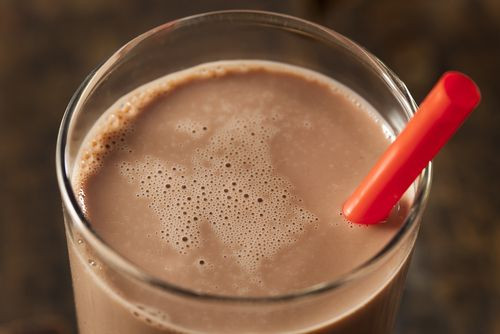Chocolate Milk Isn't Just For Kids: How The Drink Helps Your Workout, Brain, And The Environment

Chances are chocolate milk was a staple for you growing up. Kids chug the stuff no matter what the occasion, whether it’s with breakfast, lunch, or as an after-school snack. Chocolate powder, chocolate syrup — it’s all good. That is, until you get older.
Chocolate milk is for kids, right? So as an adult, it’s either regular milk (almond milk if you’re about that non-dairy life) or bust. But a scoop or drizzle of chocolate isn’t only totally OK to have as an adult, it boasts some serious benefits.
Raise The (Chocolate) Bar
Cocoa, or cacao, beans are what make chocolate a health food contender in the first place. They’re rich sources of antioxidant compounds called polyphenols and flavonoids, which work to fight cancer-causing free radicals and otherwise harmful molecules. Chocolate consumption has been associated with greater happiness and fewer risks of disease, such as cardiovascular disease, diabetes, and it lowers chances of inflammation.
The trick is to choose a bar that’s 65 percent cacao. For this reason, dark chocolate is often recommended over its milkier counterparts, since it retains more cacao than milk chocolate. Of course, higher cacao levels give chocolate a bittersweet taste and can be hard to get down when your palette is accustomed to a much sweeter flavor. Luckily, there are brands, including drug store staple Lindt, that produce quality, healthy dark chocolate with a not-so-bitter taste.
Let’s not forget cocoa powder. This powder is available unsweetened and gives baked goods, milk, even smoothies a healthier chocolate flavor. Surprisingly, it ranks in the top 10 of the top 100 polyphenol foods.
Got Chocolate Milk?
With cocoa powder and chocolate being so healthy, it makes sense to sprinkle it into your milk. Brands like Silk and Organic Valley, respectively, offer pre-packaged options made from dark chocolate and certified organic milk. Here’s how it benefits more than your childhood nostalgia.
Post-Workout Recovery
Research published in the Journal of Strength and Conditioning found drinking low-fat chocolate milk is great for recovery. Athletes who combined the drink with carbs and protein improved their training times, body composition (read: more muscle), and were in better shape than those who reached for sports drinks and carbs.
A post-workout chocolate fix doesn’t only benefit athletes, but non-athletes too. "Collectively, our research suggests that low-fat chocolate milk — easily accessible for most athletes — can improve performance and aid training for trained and amateur athletes faced with tough routines," Dr. John L. Ivy, one of the study’s authors from the University of Texas at Austin, said in a press release. "We may need more research to understand the exact mechanisms, but there's something that chocolate milk naturally has that likely gives it the post-exercise advantage."
Ivy added low-fat chocolate milk has a lot of the elements standard recovery drinks have: high-quality protein, electrolytes, potassium, sodium, and magnesium, plus B vitamins for energy. The protein in particular is what helps to repair and rebuild muscles.
Not to mention a first-of-its-kind study presented at this year’s American College of Sports Medicine’s annual conference found that drinking chocolate milk after a hard swim helps swimmers shave an average of two seconds for every 200 yards they swim. They shave half a second per 75 yard sprint. It’s why Team USA’s swim team has been swigging the stuff for years. We're looking at you, Nathan Adrian.
Boosts Brain Function
What do the countries that produce the most Nobel Laureates all have in common? They eat more chocolate. A study published in the New England Journal of Medicine found a strong correlation between chocolate consumption and Nobel prizes as flavanols, chocolate’s main ingredient we mentioned earlier, have also been found to boost brain power.
But in regard to chocolate milk, a separate study published in Practical Neurology looked at the 2007 data from the Food and Agriculture organization on per capita milk consumption in 22 countries — and Sweden, the country with the most Nobel Laureates, goes through 340 kiliograms (kg) each year; Switzerland (who ranked first for chocolate consumption in the first study) goes through 300 kg.
If A equals C, and B equals C, then mixing chocolate into your milk will help earn you a Nobel prize. Or we think. We’re not math majors.
Get Kids To Eat Healthier
Depending on how you flavor your milk, chocolate milk can be unhealthy. Nestle’s Nesquik, the market leader that’s been around since the 1980s, comes in the form of powder and syrup, boasting 13 grams of sugar per serving. When was the last time you made a glass of chocolate milk with a mere two tablespoons? Exactly.
Given these, parents and experts frequently come together to remove the drink option from school cafeterias. Only, surprisingly, that doesn’t work in their favor. Research from the Cornell Food & Brand Label, published in PLOS ONE, found that without chocolate milk, students take 10 percent less milk and waste 29 percent more of their total meals.
Sure, removing flavored milk helps tackle the growing problem that is sugar, but unless schools also implement a plan that makes plain milk more appealing, then kids miss out on convenient sources of calcium.
The bottom line: Chocolate milk is beneficial to both kids and adults so long as you sick to unsweetend dark chocolate cocoa powder and low-fat milk.



























